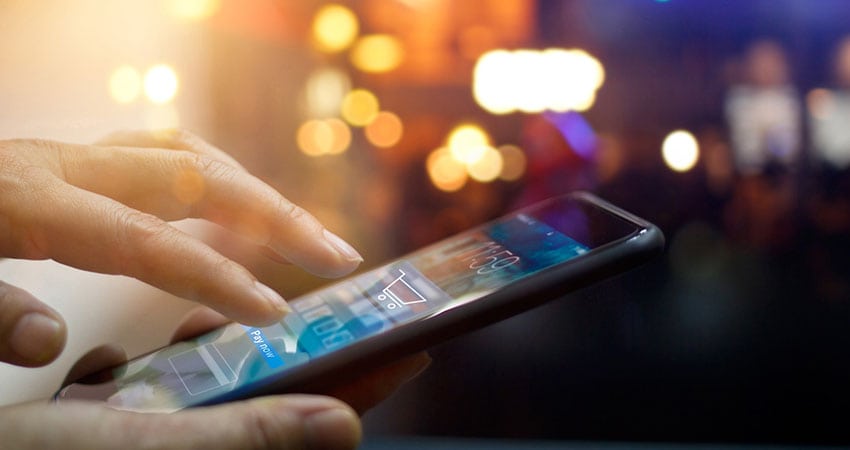With over 50% of shopping sessions now coming through mobile, the need to optimize mobile checkout experiences is becoming mission critical. Retailers and brands haven’t seemed to get their mobile conversion rates to match that of desktop (2.0% for mobile vs 2.9% for desktop). This is understandable because many consumers browse on mobile and then complete purchases later on desktop or in a second mobile session.
However, some retailers and brands are doing a great job finding the quick wins, low-hanging fruit, and up-sell opportunities within both cart and checkout experiences to boost their mobile conversion rates significantly. Here are five mobile checkout experiences from across the web including big names, up and comers and mobile app-only retailers.
Amazon (Mobile Browser or Mobile App) – Emulate if you have a high percentage of returning visitors
The mobile experience is ideal for returning or logged-in visitors. What’s more interesting is Amazon departs from ‘industry standard’ checkout experiences by requiring log-in or account sign up to access checkout and using panel fly-outs for accessing credit card, ship-to, and bill-to fields instead of a longer from. This hasn’t hurt Amazon’s sales. Amazon recently reported $200 billion dollars in annual sales in 2018. This has come in part from uber-optimization of their cart and checkout experiences. Amazon has turned their checkout experience into jet-stream like smoothness.
Best Practices:
Auto populate checkout with payment, ship-to, and bill-to fields for returning users
“Place order” at top of checkout
Fly-out “drawers” chevron buttons to access field data instead of a long scroll form
NAKD.com – Emulate if you have a younger millennial consumer
NAKD.com is a fashion retailer focused on serving millennial women. They have a combined cart and checkout that delivers a “shopping” experience including displaying “recently viewed”, “likes” and “in cart” items to imitate a shopping experience in a store. They’ve also executed the checkout page exceptionally well with robust features to reduce errors.
Best Practices:
Fly-out mini cart preview
Cart preview in Checkout creating a combined ‘cart & checkout’ experience
Auto complete address verification like CyberSource’s Address Verification solution
Opt-in buttons for “Alternative Ship-to address” instead of displaying both bill-to and ship-to addresses and Opt-in button to save for payment
Reassurance messaging near the purchase button such as “Free returns, Safe payment, Delivery in 1 to 3 days”
Lululemon.com – Emulate if you are a brand with aspirational, discretionary purchases
Let’s face it, Lululemon is hawking cute yet over-priced yoga leggings but does a great job of deemphasizing its higher price tag with distraction-free checkout experiences including the skip checkout options.
Best Practices:
Encourage users to skip checkout process entirely using mobile wallets such as Apple Pay on Product Detail Page. This can be changed to PayPal on Android or other devices.
Second option to skip checkout in Cart: Jump to Apple Pay and PayPal on Cart
Guest checkout: Require email address for shipping notification with email marketing opt-in. Offer account creation after purchase. Marketer beware: Auto-checked newsletter opt-in is iffy at best in the U.S. and illegal due to GDPR for European consumers.
Icons to help communicate shipping speed is better than “Standard vs. Express vs. Priority”
Clear form validation error messaging (icon and text under field)
Continue to payment page allows ecommerce team to test checkout forms vs. payment collection separately.
CleanersSupply.com – Emulate if you are a b2b supplier or manufacturer
CleanersSupply.com supplies hundreds of products to dry cleaners around the country. Their customers are other businesses and as such, have unique needs and sensitivities such as delivery estimates and bulk purchases. In response, CleanersSupply.com provides in-cart messaging such as “in-stock” and “estimated delivery date” to reassure users that items they need to operate their business are in-stock and will be delivered by a certain date.
Best Practices:
Free shipping threshold messaging in cart
Large text and design make the site easy to use
Delivery date estimate and in-stock messaging helps reassure users of purchase
Add notes to order for customer service
Instacart – Emulate if you sell services or products that need scheduled delivery
Even though grocery delivery service Instacart operates a mobile app instead of browser-based site, they offer some best practices to emulate. Specifically, Instacart displays “Free Delivery” messages at the top of the cart including a link to see products that will help the shopper achieve free shipping easiest. Other best practices for omnichannel retailers or brands are the two tabs at checkout that switch between “delivery” and “pick-up” at the beginning of the checkout journey instead of the middle or bottom like other retail ecommerce websites.
Best Practices:
Free delivery threshold messaging in cart
Tabs for delivery versus pick-up
Form validation using greyed out “purchase” button until all forms are completed. Information circle icon helps provide user with information without overloading them with it all at once. “You saved” subtotal on checkout as a customer reward
Image preview of items in cart instead of descriptions makes verification easy and seamless
Conclusion
We are in a post-desktop world where more consumers are willing and comfortable to complete purchases on mobile devices. Retailers and brands need to put mobile optimization of checkout at the top of their list. The slightest optimization can lead to significant increases in revenue and profitability. Best practices like mobile wallets, use of information “drawers” or “tap for more information” buttons simplify the checkout pages but provide more information when consumers need them.
Ed Kennedy is the senior director of commerce at Episerver

